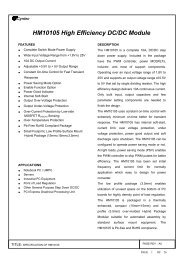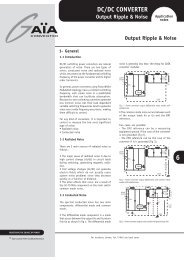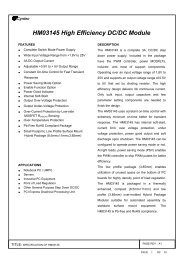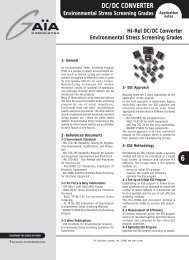DC/DC CONVERTER
DC/DC CONVERTER
DC/DC CONVERTER
Create successful ePaper yourself
Turn your PDF publications into a flip-book with our unique Google optimized e-Paper software.
<strong>DC</strong>/<strong>DC</strong> <strong>CONVERTER</strong><br />
Safety Standards<br />
Application<br />
notes<br />
Safety Standards<br />
UL1950 & EN60950<br />
1- General<br />
For the majority of <strong>DC</strong>/<strong>DC</strong> converter applications<br />
in the telecommunications and<br />
datacommunications equipment, the applicable<br />
safety standards are UL1950 (and its<br />
Canadian equivalent C22.2 No. 950-95) for<br />
North America and EN60950 for Europe.<br />
Both are titled «Standards for Safety of<br />
Information Technology Equipment (ITE),<br />
Including Electrical Business Equipment,».<br />
2- UL1950/EN60950 Safety<br />
Principle<br />
These safety standards address construction<br />
issues and are intended to prevent injury to<br />
equipment operators and service personnel as<br />
well as other forms of damage caused by :<br />
- Electric shock,<br />
- Energy hazards,<br />
- Fire,<br />
- Mechanical and heat hazards,<br />
- Radiation Hazards,<br />
- Chemical Hazards.<br />
Electric shock is due to current passing through<br />
the human body. Currents of the order of a<br />
milliampere can cause a reaction in persons in<br />
good health and may cause indirect danger<br />
due to involuntary reaction. Higher currents<br />
can have more damaging effects.<br />
Voltages up to about 40Vac peak, or 60Vdc,<br />
are not generally regarded as dangerous under<br />
dry conditions, but parts which have to be<br />
touched or handled should be at earth potential<br />
or properly insulated. It is normal to provide<br />
two levels of protection for operators to prevent<br />
electric shock.<br />
Energy Hazards can be caused by arcing or<br />
ejection of molten metal when adjacent poles<br />
of high current supplies or high capacitance<br />
circuits are short-circuited. Protection is made<br />
by separation, by shielding or by using safety<br />
interlocks.<br />
Fire risks may result from overloads,<br />
component failure, insulation breakdown or<br />
loose connections. Fires should not spread<br />
beyond the immediate vicinity of the source of<br />
the fire or cause damage to the surroundings<br />
of the equipment.<br />
Mechanical and heat hazards should be<br />
prevented by providing adequate stability, by<br />
avoiding sharp edges and points or by<br />
restricting access to dangerous parts.<br />
Radiation Hazards encountered can be sonic,<br />
radio frequency, infra-red, high intensity visible<br />
and coherent light, ionising, etc.<br />
Requirements are necessary to keep person<br />
exposures to acceptable levels.<br />
Chemical Hazards through contact with<br />
chemicals, their vapours and fumes are required<br />
to be limited under normal and abnormal conditions.<br />
6<br />
REDEFINING THE SOURCE OF POWER<br />
© Gaia Converter FC97-040.08/04 Revision B<br />
For locations, phone, fax, E-Mail see back cover
Safety Standards<br />
Application<br />
notes<br />
3- Basic Definition according to UL1950, EN60950<br />
3-1 Generic Terminology<br />
The following terms are used frequently.<br />
The definitions given here are based<br />
on full definitions in EN 60950 but<br />
partially<br />
abbreviated to help the<br />
explanation.<br />
Primary Circuit : An internal circuit<br />
which is directly connected to the<br />
external supply mains or other<br />
equivalent source (such as a motorgenerator<br />
set) which supplies the<br />
electric power.<br />
Secondary Circuit : A circuit which has<br />
no direct connection to primary power<br />
and derives its power from a transformer,<br />
converter or equivalent isolation<br />
device, or from a battery.<br />
Hazardous (or Excessive) Voltage : A<br />
voltage exceeding 42.4Vac peak or<br />
60Vdc, existing in a circuit which does<br />
not meet the requirements for a limited<br />
current circuit.<br />
Limited Current Circuit : A circuit which<br />
is so designed and protected that, under<br />
both normal conditions and a likely fault<br />
condition, the current which can be<br />
drawn is not hazardous. Limits are<br />
detailed in the UL1950 & EN60950 standards.<br />
Operational Insulation: The<br />
operationnal level of insulation<br />
acknowledges that isolation between<br />
primary and secondary circuits is<br />
required for proper operation of the<br />
device. However, there is no protection<br />
against electric shock at the output<br />
if there is a breakdown/fault in<br />
the primary-to-secondary insulation.<br />
Basic Insulation : basic insulation<br />
provides for one layer of “basic protection”<br />
against electrical shock. Basic<br />
insulation can be used in conjunction<br />
with other supporting circuitry to<br />
ensure a SELV output, following a<br />
fault, under all possible input conditions.<br />
Supplementary Insulation :<br />
Independent insulation applied in addition<br />
to basic insulation to ensure protection<br />
against electric shock in the<br />
event of a failure of the basic insulation.<br />
Double Insulation : Insulation<br />
comprising both basic insulation and<br />
supplementary insulation.<br />
Reinforced Insulation : reinforced<br />
insulation provides for 2 separate<br />
levels of protection. It ensures,<br />
without supporting circuitry, a SELV<br />
output, following a fault, under all<br />
possible input conditions.<br />
Extra Low Voltage (ELV) Circuit : A<br />
secondary circuit with voltages between<br />
any two conductors of the ELV circuit,<br />
and between any one such conductor<br />
and earth, not exceeding 42.4 V AC<br />
peak or 60 V <strong>DC</strong>, under normal<br />
operating conditions, which is<br />
separated from hazardous voltage by<br />
at least basic insulation, and which<br />
neither meets all of the requirements<br />
for an SELV circuit nor for a limited<br />
current circuit.<br />
Safety Extra-low Voltage (SELV) Circuit<br />
: A secondary circuit which is so<br />
designed and protected that, under<br />
normal and single fault conditions, the<br />
voltage between any two conductors<br />
and, for class I equipment, between<br />
any one such conductor and the<br />
equipment protective earthing terminal,<br />
does not exceed a safe value (42.4<br />
Vac peak or 60 Vdc). Under single fault<br />
conditions the voltage is at lowed<br />
to reach 71 Vac peak or 120 Vdc for a<br />
maximum time of 0.2 s. Note: Safety<br />
levels are specified in terms of <strong>DC</strong> and<br />
AC voltages because the different types<br />
of voltages have dangerous effects<br />
at different levels.<br />
Overvoltage Category : Assigns maximum<br />
expected transient voltages to<br />
nominal mains supply voltages.<br />
Examples of preferred values of such<br />
transient voltages according to IEC<br />
60664-1 are: 500V, 800V, 1500V, 2500V,<br />
4000V. The maximum expected<br />
transient voltage of an overvoltage<br />
category II circuit with a nominal voltage<br />
of >150 to 300V is 2500V. A<br />
secondary circuit derived from an<br />
overvoltage category II primary circuit<br />
is considered to be subject to<br />
overvoltage category I, i.e. in case of<br />
a primary voltage of >150 to 300 V the<br />
secondary transient voltage is 1500V.<br />
Working Voltage : The highest voltage<br />
to which the insulation under<br />
consideration is, or can be, subjected<br />
when the equipment is operating at its<br />
rated voltage under conditions of normal<br />
use.<br />
Creepage Distance : The shortest path<br />
between two conductive parts, or<br />
between a conductive part and the<br />
bounding surface of the equipment,<br />
measured along the surface of the<br />
insulation.<br />
Clearance : The shortest distance<br />
between two conductive parts, or<br />
between a conductive part and the<br />
bounding surface of the equipment,<br />
measured through air.<br />
6<br />
© Gaia Converter FC97-040.08/04 Revision B<br />
For locations, phone, fax, E-Mail see back cover<br />
2
Safety Standards<br />
Application<br />
notes<br />
3-2 Power System Safety Requirements Terminology<br />
Telecommunications Network Voltage<br />
(TNV) Circuit :<br />
A secondary circuit in the equipment<br />
to which the accessible area of contact<br />
is limited and that is so designed<br />
and protected that, under normal and<br />
single fault conditions, the voltages do<br />
not exceed specified limiting values.<br />
Voltage limits after a single fault are<br />
given in Fig. 15 of IEC/EN60950 (1500<br />
V during 1 ms, 400 V during 0.2 s, 71 V<br />
AC peak or 120 V <strong>DC</strong> continuously). TNV<br />
circuits are classified as TNV-1, TNV-2<br />
and TNV-3 circuits:<br />
TNV-1 Circuit : A TNV circuit whose<br />
normal operating voltages do not<br />
exceed the limits for an SELV circuit<br />
value (42.4 Vac peak or 60 Vdc) under<br />
normal operating conditions and on<br />
which overvoltages from<br />
telecommunication networks (up to<br />
1500 V peak) are possible.<br />
TNV-2 Circuit : A TNV circuit whose<br />
normal operating voltages exceed the<br />
limits for an SELV circuit, but do not<br />
exceed 71 Vac peak or 120 Vdc under<br />
normal operating conditions and which<br />
is not subject to overvoltages from<br />
telecommunication networks.<br />
TNV-3 Circuit : A TNV circuit whose<br />
normal operating voltages exceed the<br />
limits for an SELV circuit, but do not<br />
exceed 71 Vac peak or 120 Vdc under<br />
normal operating conditions and on<br />
which overvoltages from<br />
telecommunication networks (up to<br />
1500 V peak) are possible.<br />
Class I Equipment : Equipment where<br />
protection against electric shock is<br />
achieved by using basic insulation and<br />
by providing a means of connecting to<br />
the protective earthing conductor in the<br />
building wiring those conductive parts<br />
that are otherwise capable of assuming<br />
hazardous voltages if the basic<br />
insulation fails. Note: Class I equipment<br />
may have<br />
parts with double insulation or<br />
reinforced insulation, or parts operating<br />
in SELV circuits.<br />
Class II Equipment : Equipment in which<br />
protection against electric shock does<br />
not rely on basic insulation only, but in<br />
which additional safety precautions,<br />
such as double insulation or reinforced<br />
insulation, are provided, there being<br />
no reliance on either protective<br />
earthing or installation conditions.<br />
Class III Equipment : Equipment in<br />
which protection against electric shock<br />
relies upon supply from SELV circuits<br />
and in which hazardous voltages are<br />
not generated.<br />
TN-S Power System : A power distribution<br />
system having separate neutral and<br />
protective earth conductors through-out<br />
the system.<br />
TN-C Power System : A power distribution<br />
system in which neutral and<br />
protective functions are combined in a<br />
single conductor throughout the<br />
system.<br />
TT Power System : A power distribution<br />
system having one point directly<br />
earthed, the exposed conductive parts<br />
of the installation being connected to<br />
earth independent of the power system.<br />
IT Power System : A power distribution<br />
system having no direct connection<br />
to earth, the exposed conductive parts<br />
of the electrical installation being<br />
earthed.<br />
6<br />
© Gaia Converter FC97-040.08/04 Revision B<br />
For locations, phone, fax, E-Mail see back cover<br />
3
Safety Standards<br />
Application<br />
notes<br />
4- Safety Consideration when using <strong>DC</strong>/<strong>DC</strong>’s on a Power System<br />
For safety agency approval of a power system in which<br />
<strong>DC</strong>/<strong>DC</strong> modules are used, the <strong>DC</strong>/<strong>DC</strong> module must be<br />
installed in compliance with requirements of the UL1950,<br />
EN60950 standards : i.e if the output circuit is operator<br />
accessible, it shall be a SELV circuit.<br />
SELV circuits must be separated from hazardous voltages<br />
(e.g primary circuits) by two levels of protection which<br />
may be :<br />
• double or reinforced insulation,<br />
• or basic insulation combined with a secondary<br />
protective barrier.<br />
Generally <strong>DC</strong>/<strong>DC</strong> Converters are power by an input bus<br />
that comes from a front-end which can be an AC/<strong>DC</strong><br />
powered supply, a transformer, a charger or a battery.<br />
It is the sole responsability of the user to ensure<br />
compliance of the front-end with the relevant safety<br />
requiements.<br />
The following table resumes some possible installation<br />
configuration using GAIA Converter <strong>DC</strong>/<strong>DC</strong> modules.<br />
Bus voltage range at the<br />
input of <strong>DC</strong>/<strong>DC</strong> converter<br />
Mandatory safety status of<br />
the input <strong>DC</strong>/<strong>DC</strong> bus<br />
<strong>DC</strong>/<strong>DC</strong> converter<br />
minimum requirements<br />
Circuitry to achieve safety compliance<br />
Resulting safety at the<br />
<strong>DC</strong>/<strong>DC</strong> converter output<br />
Voltage : < 60 V<strong>DC</strong><br />
Basic isolation<br />
with ELV circuit<br />
Basic isolation<br />
with earthed SELV circuit<br />
Operationnal insulation<br />
Operationnal insulation<br />
Input fuse, output supressor diode and<br />
earthed output circuit<br />
/<br />
Earthed SELV circuit<br />
SELV circuit<br />
Hazardous voltage:>60 V<strong>DC</strong><br />
Basic isolation with<br />
hazardous voltage<br />
Double or reinforced insulation<br />
with hazadous voltage<br />
Operationnal insulation<br />
Operationnal insulation<br />
Input fuse, output supressor diode and<br />
earthed output circuit<br />
Input fuse, output supressor diode<br />
Earthed SELV circuit<br />
SELV circuit<br />
Where :<br />
- «Mandatory safety status of the input <strong>DC</strong>/<strong>DC</strong> bus»<br />
describes the necessary input bus status entering in the<br />
<strong>DC</strong>/<strong>DC</strong> module to be compliant with safety requirements.This<br />
input bus can come from an AC/<strong>DC</strong> power supply, a transformer/rectifier,<br />
a battery charger, a simple battery, ....<br />
This front-end can provide :<br />
• a basic isolation or double or reinforced isolation,<br />
• an output voltage below 60 V<strong>DC</strong> or above 60 V<strong>DC</strong>,<br />
• an output that can be ELV or SELV circuitry,<br />
• an output that can be earthed or not.<br />
It is the sole responsability of the user to ensure<br />
compliance of the front-end with the relevant safety<br />
requirements.<br />
- «<strong>DC</strong>/<strong>DC</strong> converter minimum requirements» describes the<br />
isolation requirements at minimum level. If the isolation<br />
of the <strong>DC</strong>/<strong>DC</strong> module is more than operationnal i.e<br />
supplementary or reinforced, the circuitry to achieve safety<br />
requirements is not necessary.<br />
- «Circuitry to achieve safety compliance» : please find<br />
the schematic safety concept.<br />
6<br />
The earth connection has to be provided by the user according to the relevant safety standard, e.g. IEC/EN 60950.<br />
The user shall provide an approved fuse (type with the lowest rating suitable for the application) in a non-earthed input line directly at the input of the <strong>DC</strong>-<strong>DC</strong> converter.<br />
For UL’s purpose, the fuse needs to be UL-listed.<br />
Each suppressor diode should be dimensioned in such a way, that in the case of an isolation fault the diode is able to limit the outputvoltage to SELV (
Safety Standards<br />
Application<br />
notes<br />
5- UL1950 & EN60950 Requirements for <strong>DC</strong>/<strong>DC</strong> Converter<br />
The UL1950 & EN60950 safety<br />
standards address construction issues<br />
and are intended to prevent injury to<br />
equipment operators and service personnel<br />
as well as other forms of<br />
damage caused by electric shock, fire,<br />
energy hazards, mechanical and heat<br />
hazards, or chemical hazards.<br />
For component-level, modular <strong>DC</strong>/<strong>DC</strong><br />
converters, the main qualification<br />
issues concern protection against<br />
electric shock and thermal/heat<br />
hazards.<br />
The three main areas of investigation<br />
are :<br />
- electrical insulation,<br />
- electric strength (i.e., isolation<br />
voltage),<br />
- thermal insulation.<br />
Electrical Insulation : For <strong>DC</strong>/<strong>DC</strong><br />
converters, insulation requirements<br />
consist primarily of minimum spacings<br />
(creepage and clearance) between<br />
primary and secondary circuits<br />
including pcb traces, transformer<br />
windings, I/O capacitors, optocouplers,<br />
etc.<br />
The minimum-spacing requirements<br />
are eliminated or relaxed significantly<br />
if an approved “solid insulator”<br />
(encapsulate or potting compound) is<br />
used. The three distinct grades of<br />
electrical insulation are :<br />
- Operational: The operational level of<br />
insulation acknowledges that isolation<br />
between primary and secondary<br />
circuits is required for proper<br />
operation of the device. However,<br />
there is no protection against electric<br />
shock at the output if there is a<br />
breakdown/fault in the primary-tosecondary<br />
insulation. The output is<br />
SELV only when the input is SELV.<br />
- Basic : Basic insulation provides<br />
for one layer of “basic protection”<br />
against shock. Basic insulation can be<br />
used in conjunction with other<br />
supporting circuitry to ensure a SELV<br />
output, following a fault, under all<br />
possible input conditions.<br />
- Reinforced : reinforced insulation<br />
provides for 2 separate levels of<br />
protection. It ensures, without<br />
supporting circuitry, a SELV output,<br />
following a fault, under all possible<br />
input conditions.<br />
Electric Strength : Achieving different<br />
grades of electrical insulation requires<br />
different minimum isolation voltages<br />
depending on the peak internal<br />
working voltage (usually much higher<br />
than the maximum input or output<br />
voltages) of the device. The specific<br />
voltages are defined by the UL and EN<br />
specs. One example is that a device<br />
with a peak internal working voltage<br />
of 120V must guarantee 1500Vdc<br />
isolation to qualify for BASIC<br />
insulation.<br />
Thermal Insulation : The temperature<br />
at which a manufacturer begins to<br />
derate a given <strong>DC</strong>/<strong>DC</strong> converter (i.e.,<br />
its maximum full-power temperature)<br />
and the temperature at which UL1950/<br />
EN60950 begins to derate that same<br />
device may be very different.<br />
Transformers are usually the critical<br />
area of concern. The assorted<br />
materials that make up a transformer<br />
(wire, bobbin, tape, cores, silicone,<br />
etc.), and the manner in which those<br />
materials chemically interact at high<br />
temperatures, constitute a “thermal<br />
insulating system,” and UL/EN rates<br />
such systems. Developing a thermal<br />
insulating system and subsequently<br />
having a standards agency approve it<br />
requires lengthy aging and<br />
temperature-cycling processes to<br />
determine if any of the constituent<br />
materials interact in a manner that<br />
forms contaminants.<br />
The majority of today’s <strong>DC</strong>/<strong>DC</strong><br />
converters utilize transformers<br />
constructed with class A (i.e., unapproved)<br />
thermal insulating<br />
systems. Such transformers are<br />
considered safety hazards whenever<br />
their internal temperatures exceed<br />
+105°C.<br />
Most of these <strong>DC</strong>/<strong>DC</strong> converters<br />
(based on thermal measurements/<br />
calculations relating to output power<br />
and derating curves) actually require<br />
transformers that can officially<br />
withstand operating temperatures up<br />
to +130°C.<br />
This grade of transformer requires a<br />
recognized Class B (+130°C) or Class F<br />
(+155°C) thermal insulating system.<br />
Such transformers must be assembled<br />
using an approved system or<br />
purchased, fully assembled, as a<br />
“system” from a qualified supplier.<br />
GAIA Converter purchases assembled<br />
transformers and our transformer<br />
vendors are both approved class B and<br />
Class F thermal insulating systems.<br />
Most UL1950 & EN60950 approved <strong>DC</strong>/<br />
<strong>DC</strong> converters on the market today,<br />
under their conditions of acceptance,<br />
have a statement that says the device<br />
has OPERATIONAL insulation only. This<br />
means there is no protection against<br />
electric shock in the event of a<br />
breakdown between primary and<br />
secondary. The output is considered<br />
SELV (Safety Extra Low Voltage,<br />
Safety Standards<br />
Application<br />
notes<br />
6- UL1950 & EN60950 Definition Responsibility and Approval Agencies<br />
The Geneva, Switzerland-based International<br />
Electrotechnical Commission<br />
(IEC) develops «generic» technical<br />
standards for electronic products and<br />
components. Designed for use by<br />
different industries and governments<br />
around the world, IEC standards have<br />
no national orientation and no<br />
effectivity or compliance dates. The<br />
Commission has no testing facilities or<br />
enforcement powers, and the adoption<br />
of IEC standards is purely<br />
voluntary. The USA’s UL1950 and<br />
Europe’s EN60950 are both derived<br />
from the IEC950 safety standard.<br />
The 18 member countries of the<br />
European Eco-nomic Area (EEA) have<br />
created CENELEC, the European<br />
Committee for Electrotechnical<br />
Standardization (Comite Europeen de<br />
Normalisation Electrotechnique). The<br />
Brussels, Belgium-based CENELEC<br />
both creates its own standards and<br />
adopts standards authored by others<br />
(such as IEC), adapting them to the<br />
needs of the European Union (EU).<br />
CENELEC issues both «European<br />
normalizing» documents (with an<br />
«EN» prefix) and «harmonizing documents»<br />
(with an «HD» prefix).<br />
CENELEC also applies effectivity, but<br />
not compliance, dates to standards.<br />
Once CENELEC issues a standard, all<br />
member countries must adopt it in<br />
place of any existing national standards,<br />
though each country is<br />
permitted deviations from the<br />
CENELEC spec.<br />
For most <strong>DC</strong>/<strong>DC</strong> converters, the<br />
relevant CENELEC safety specification<br />
is EN60950.<br />
Underwriters Laboratories, Inc. UL is a<br />
USA-based, non-governmental, notfor-profit<br />
organization that<br />
establishes product-safety standards.<br />
The relevant UL safety specification<br />
for <strong>DC</strong>/<strong>DC</strong> converters is UL1950.<br />
Canadian Standards Association CSA is<br />
the Canadian equivalent of UL. It is an<br />
independent agency that establishes<br />
standards. Their relevant specification<br />
for <strong>DC</strong>/<strong>DC</strong>’s, C22.2 No. 950-95, is<br />
identical to UL1950.<br />
V.D.E. Verband Deutsher<br />
Elektrotechniker (Association of<br />
German Electrical Engineers) is a<br />
private German organization that, like<br />
UL and CSA, establishes productsafety<br />
standards,<br />
B.S.I. The British Standards Institution<br />
is a quasi-governmental agency<br />
that develops standards in the United<br />
Kingdom.<br />
Hereafter are some agencies that<br />
conduct testing according to UL1950<br />
or EN60950 and delivered qualification<br />
form.<br />
Underwriters Laboratories, Inc.<br />
conducts product-safety testing.<br />
Conforming products are usually<br />
designated as UL «Listed» or UL<br />
«Recognized.» UL is also an EUaccredited<br />
testing agency.<br />
The relevant UL safety spec for <strong>DC</strong>/<strong>DC</strong><br />
converters is UL1950, and conforming<br />
products can carry the UL logo.<br />
Canadian Standards Association<br />
conducts also product-safety testing.<br />
Their relevant specification for <strong>DC</strong>/<br />
<strong>DC</strong>’s, C22.2 No. 950-95, is identical to<br />
UL1950.<br />
V.D.E. Verband Deutsher<br />
Elektrotechniker conducts product<br />
testing, and issues certificates of<br />
approval. VDE tests for <strong>DC</strong>/<strong>DC</strong><br />
converters are established according<br />
to EN60950.<br />
T.U.V. Technisher Uberwachungs-<br />
Verein is a testing agency only. They<br />
have been authorized by VDE to test<br />
and approve products to VDE standards.<br />
Unlike VDE, TUV has offices in<br />
the USA, and they are often hired by<br />
US-based companies to approve<br />
products, which can then carry both<br />
the VDE and TUV logos.<br />
L.C.I.E is the French testing Agency<br />
that carries EN60950 testing approval.<br />
B.S.I. The British Standards Institution<br />
is a quasi-governmental agency<br />
that tests products in the United<br />
Kingdom.<br />
B.A.B.T. The British Approvals Board<br />
for Telecommunications is a private<br />
organization that approves telecom<br />
equipment sold into the UK market.<br />
BABT both conducts its own testing<br />
and accredits independent testing<br />
laboratories.<br />
6<br />
© Gaia Converter FC97-040.08/04 Revision B<br />
For locations, phone, fax, E-Mail see back cover<br />
6
For more detailed specifications and applications information, contact :<br />
International Headquarters<br />
GAÏA Converter - France<br />
ZI de la Morandière<br />
33185 LE HAILLAN - FRANCE<br />
Tel. : + (33)-5-57-92-12-80<br />
Fax : + (33)-5-57-92-12-89<br />
Represented by :<br />
North American Headquarters<br />
GAÏA Converter Canada, Inc<br />
4038 Le Corbusier Blvd<br />
LAVAL, QUEBEC - CANADA H7L 5R2<br />
Tel. : (514)-333-3169<br />
Fax : (514)-333-4519<br />
Information given in this datasheet is believed to be accurate and reliable. However, no responsibility is assumed for the consequence of its use nor for any infringement of patents or other rights of third parties which may result from its use.<br />
These products are sold only according to GAIA Converter general conditions of sale, unless otherwise confirmed by writing. Specifications subject to change without notice.<br />
Printed in France by GAIA Converter Gaia Converter FC97-040.08/04 Revision B. Graphisme : Philippe Clicq
















